MGT5STR: Fonterra's Strategic Management and International Expansion
VerifiedAdded on 2023/06/03
|11
|3056
|269
Report
AI Summary
This report examines Fonterra's strategic management approach to international market expansion, focusing on the Australian agribusiness sector. It begins with an overview of the sector and then identifies international opportunities for Fonterra, particularly in markets like India, and suggests suitable international strategies, including multi-domestic, global, and transnational approaches. The report analyzes appropriate entry methods such as strategic alliances and joint ventures, while also discussing inappropriate methods like acquisition and greenfield investment. Finally, it offers recommendations for Fonterra's future strategic direction, emphasizing the use of price differentiation strategies. The report highlights Fonterra's cooperative structure and its ability to leverage its brand, supply chain, and international partnerships for growth. The report also covers core competencies, competitive advantages, and the external environment, all contributing to a comprehensive strategic analysis.
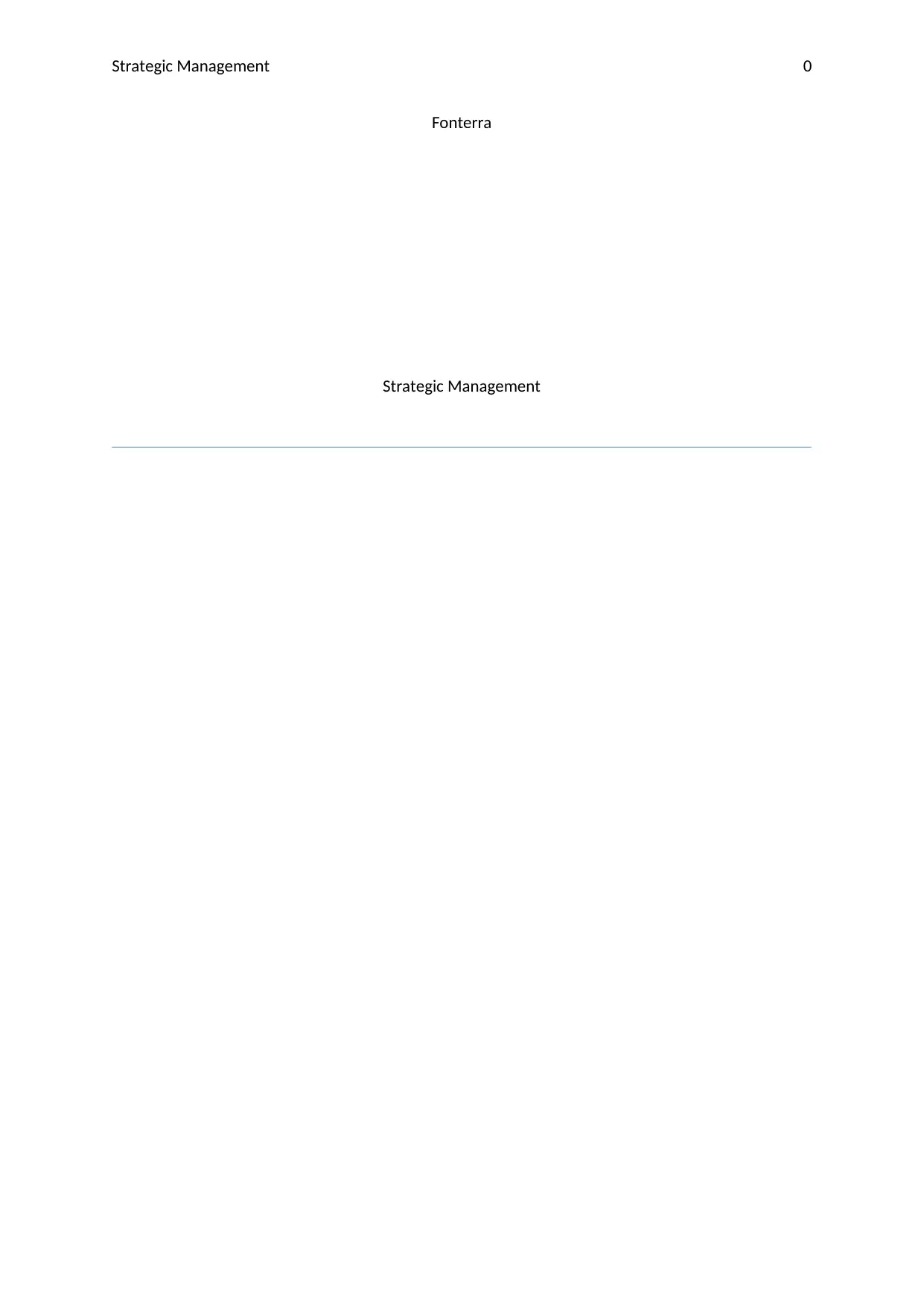
Strategic Management 0
Fonterra
Strategic Management
Fonterra
Strategic Management
Paraphrase This Document
Need a fresh take? Get an instant paraphrase of this document with our AI Paraphraser
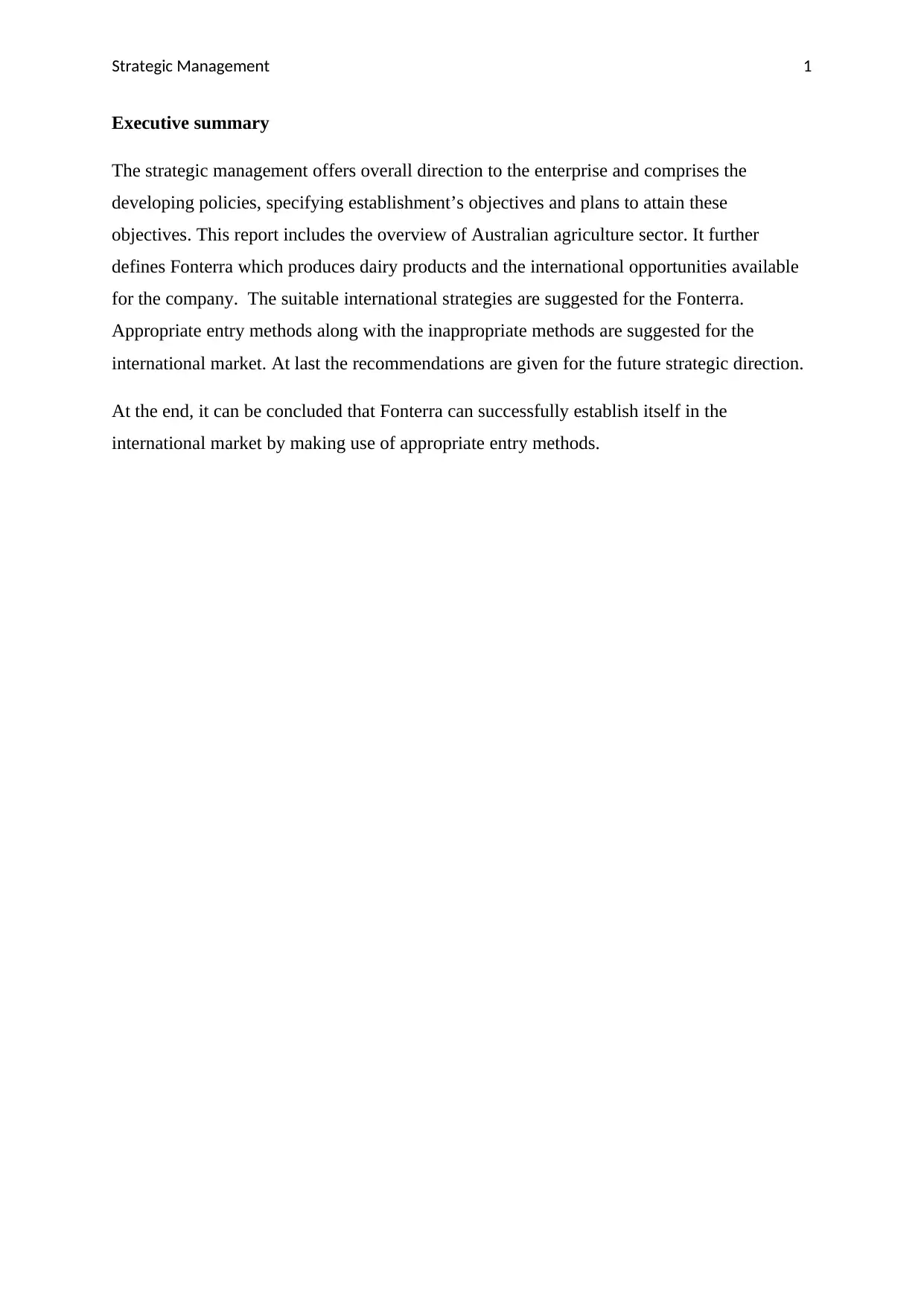
Strategic Management 1
Executive summary
The strategic management offers overall direction to the enterprise and comprises the
developing policies, specifying establishment’s objectives and plans to attain these
objectives. This report includes the overview of Australian agriculture sector. It further
defines Fonterra which produces dairy products and the international opportunities available
for the company. The suitable international strategies are suggested for the Fonterra.
Appropriate entry methods along with the inappropriate methods are suggested for the
international market. At last the recommendations are given for the future strategic direction.
At the end, it can be concluded that Fonterra can successfully establish itself in the
international market by making use of appropriate entry methods.
Executive summary
The strategic management offers overall direction to the enterprise and comprises the
developing policies, specifying establishment’s objectives and plans to attain these
objectives. This report includes the overview of Australian agriculture sector. It further
defines Fonterra which produces dairy products and the international opportunities available
for the company. The suitable international strategies are suggested for the Fonterra.
Appropriate entry methods along with the inappropriate methods are suggested for the
international market. At last the recommendations are given for the future strategic direction.
At the end, it can be concluded that Fonterra can successfully establish itself in the
international market by making use of appropriate entry methods.
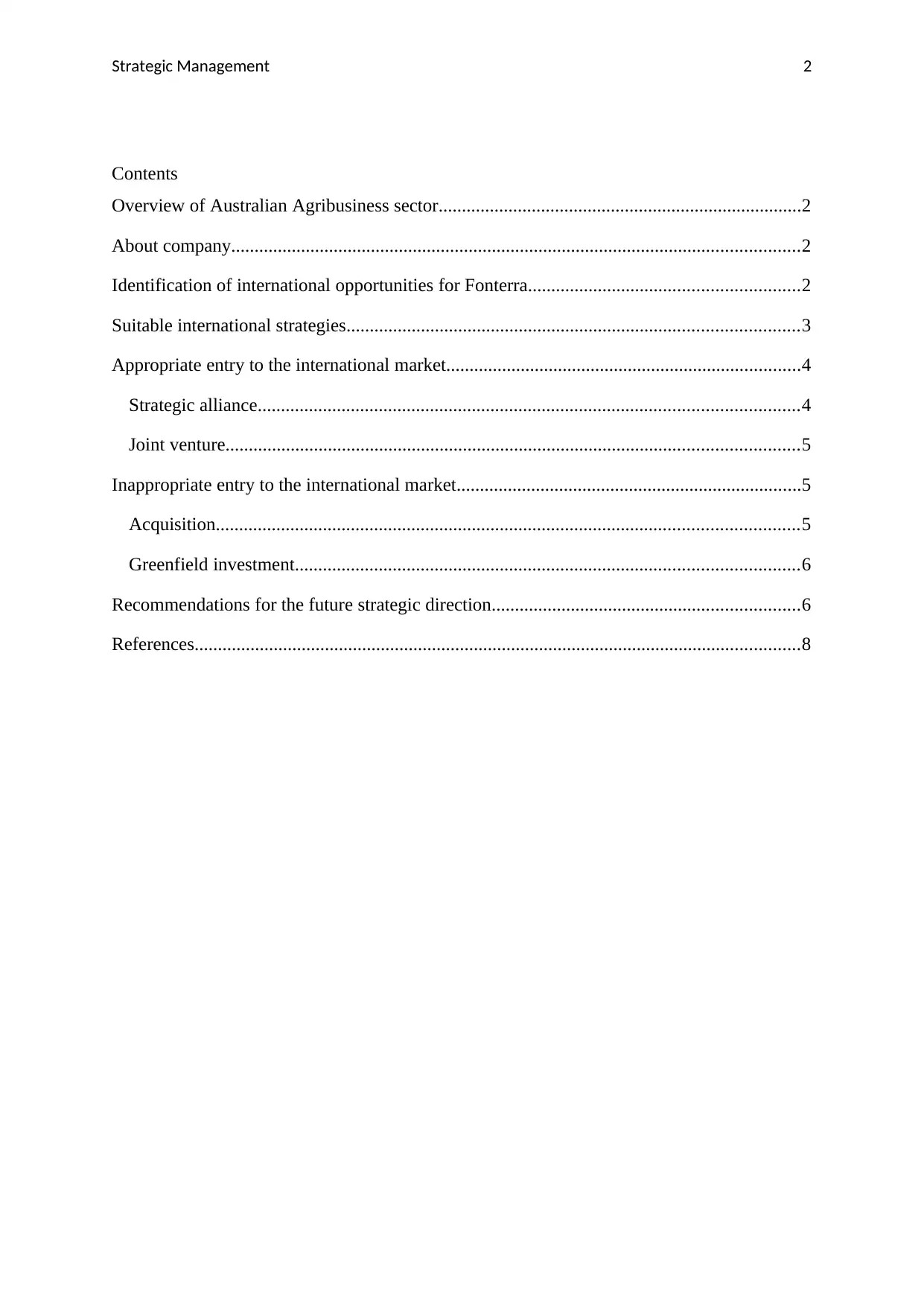
Strategic Management 2
Contents
Overview of Australian Agribusiness sector..............................................................................2
About company..........................................................................................................................2
Identification of international opportunities for Fonterra..........................................................2
Suitable international strategies.................................................................................................3
Appropriate entry to the international market............................................................................4
Strategic alliance....................................................................................................................4
Joint venture...........................................................................................................................5
Inappropriate entry to the international market..........................................................................5
Acquisition.............................................................................................................................5
Greenfield investment............................................................................................................6
Recommendations for the future strategic direction..................................................................6
References..................................................................................................................................8
Contents
Overview of Australian Agribusiness sector..............................................................................2
About company..........................................................................................................................2
Identification of international opportunities for Fonterra..........................................................2
Suitable international strategies.................................................................................................3
Appropriate entry to the international market............................................................................4
Strategic alliance....................................................................................................................4
Joint venture...........................................................................................................................5
Inappropriate entry to the international market..........................................................................5
Acquisition.............................................................................................................................5
Greenfield investment............................................................................................................6
Recommendations for the future strategic direction..................................................................6
References..................................................................................................................................8
⊘ This is a preview!⊘
Do you want full access?
Subscribe today to unlock all pages.

Trusted by 1+ million students worldwide
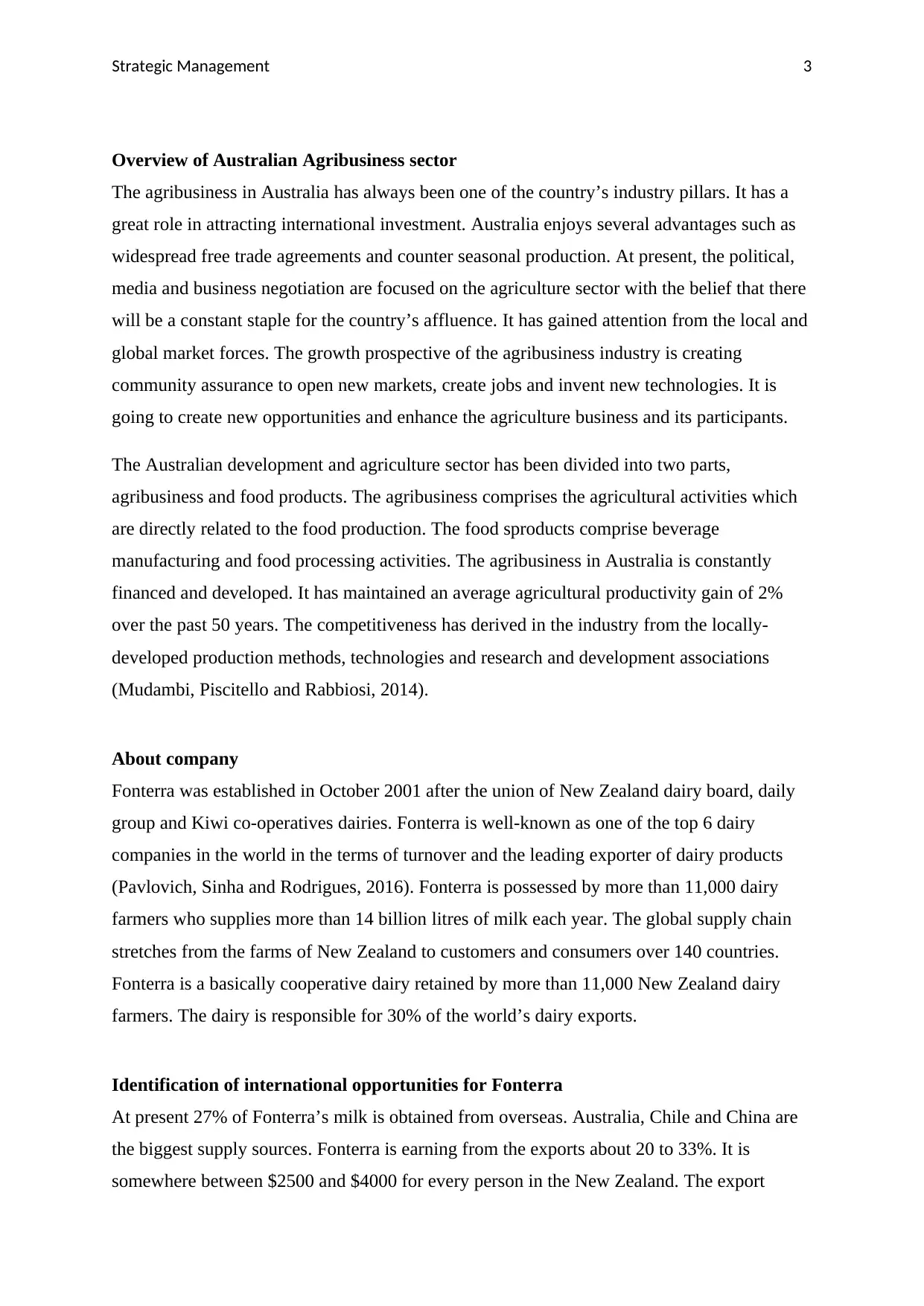
Strategic Management 3
Overview of Australian Agribusiness sector
The agribusiness in Australia has always been one of the country’s industry pillars. It has a
great role in attracting international investment. Australia enjoys several advantages such as
widespread free trade agreements and counter seasonal production. At present, the political,
media and business negotiation are focused on the agriculture sector with the belief that there
will be a constant staple for the country’s affluence. It has gained attention from the local and
global market forces. The growth prospective of the agribusiness industry is creating
community assurance to open new markets, create jobs and invent new technologies. It is
going to create new opportunities and enhance the agriculture business and its participants.
The Australian development and agriculture sector has been divided into two parts,
agribusiness and food products. The agribusiness comprises the agricultural activities which
are directly related to the food production. The food sproducts comprise beverage
manufacturing and food processing activities. The agribusiness in Australia is constantly
financed and developed. It has maintained an average agricultural productivity gain of 2%
over the past 50 years. The competitiveness has derived in the industry from the locally-
developed production methods, technologies and research and development associations
(Mudambi, Piscitello and Rabbiosi, 2014).
About company
Fonterra was established in October 2001 after the union of New Zealand dairy board, daily
group and Kiwi co-operatives dairies. Fonterra is well-known as one of the top 6 dairy
companies in the world in the terms of turnover and the leading exporter of dairy products
(Pavlovich, Sinha and Rodrigues, 2016). Fonterra is possessed by more than 11,000 dairy
farmers who supplies more than 14 billion litres of milk each year. The global supply chain
stretches from the farms of New Zealand to customers and consumers over 140 countries.
Fonterra is a basically cooperative dairy retained by more than 11,000 New Zealand dairy
farmers. The dairy is responsible for 30% of the world’s dairy exports.
Identification of international opportunities for Fonterra
At present 27% of Fonterra’s milk is obtained from overseas. Australia, Chile and China are
the biggest supply sources. Fonterra is earning from the exports about 20 to 33%. It is
somewhere between $2500 and $4000 for every person in the New Zealand. The export
Overview of Australian Agribusiness sector
The agribusiness in Australia has always been one of the country’s industry pillars. It has a
great role in attracting international investment. Australia enjoys several advantages such as
widespread free trade agreements and counter seasonal production. At present, the political,
media and business negotiation are focused on the agriculture sector with the belief that there
will be a constant staple for the country’s affluence. It has gained attention from the local and
global market forces. The growth prospective of the agribusiness industry is creating
community assurance to open new markets, create jobs and invent new technologies. It is
going to create new opportunities and enhance the agriculture business and its participants.
The Australian development and agriculture sector has been divided into two parts,
agribusiness and food products. The agribusiness comprises the agricultural activities which
are directly related to the food production. The food sproducts comprise beverage
manufacturing and food processing activities. The agribusiness in Australia is constantly
financed and developed. It has maintained an average agricultural productivity gain of 2%
over the past 50 years. The competitiveness has derived in the industry from the locally-
developed production methods, technologies and research and development associations
(Mudambi, Piscitello and Rabbiosi, 2014).
About company
Fonterra was established in October 2001 after the union of New Zealand dairy board, daily
group and Kiwi co-operatives dairies. Fonterra is well-known as one of the top 6 dairy
companies in the world in the terms of turnover and the leading exporter of dairy products
(Pavlovich, Sinha and Rodrigues, 2016). Fonterra is possessed by more than 11,000 dairy
farmers who supplies more than 14 billion litres of milk each year. The global supply chain
stretches from the farms of New Zealand to customers and consumers over 140 countries.
Fonterra is a basically cooperative dairy retained by more than 11,000 New Zealand dairy
farmers. The dairy is responsible for 30% of the world’s dairy exports.
Identification of international opportunities for Fonterra
At present 27% of Fonterra’s milk is obtained from overseas. Australia, Chile and China are
the biggest supply sources. Fonterra is earning from the exports about 20 to 33%. It is
somewhere between $2500 and $4000 for every person in the New Zealand. The export
Paraphrase This Document
Need a fresh take? Get an instant paraphrase of this document with our AI Paraphraser
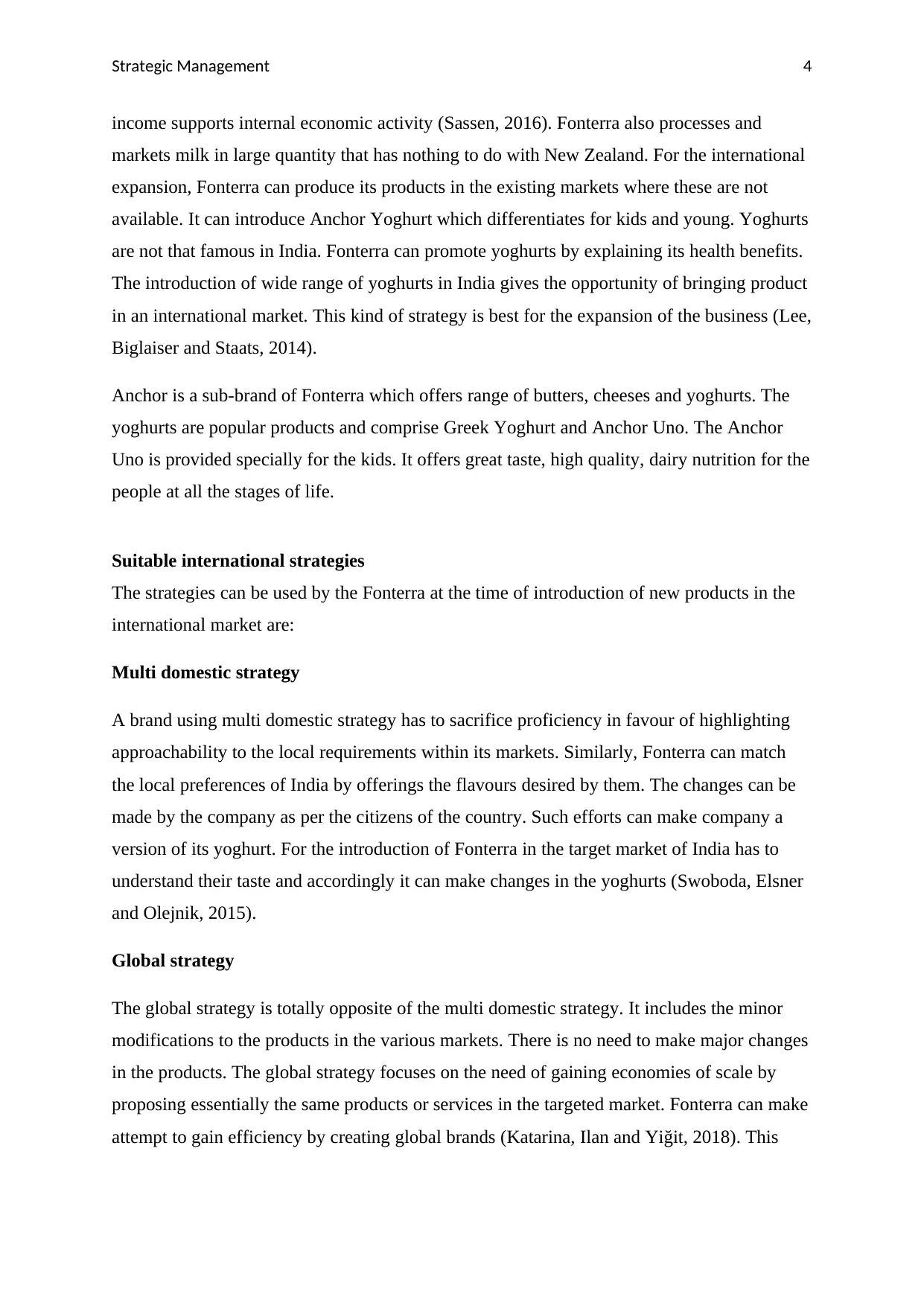
Strategic Management 4
income supports internal economic activity (Sassen, 2016). Fonterra also processes and
markets milk in large quantity that has nothing to do with New Zealand. For the international
expansion, Fonterra can produce its products in the existing markets where these are not
available. It can introduce Anchor Yoghurt which differentiates for kids and young. Yoghurts
are not that famous in India. Fonterra can promote yoghurts by explaining its health benefits.
The introduction of wide range of yoghurts in India gives the opportunity of bringing product
in an international market. This kind of strategy is best for the expansion of the business (Lee,
Biglaiser and Staats, 2014).
Anchor is a sub-brand of Fonterra which offers range of butters, cheeses and yoghurts. The
yoghurts are popular products and comprise Greek Yoghurt and Anchor Uno. The Anchor
Uno is provided specially for the kids. It offers great taste, high quality, dairy nutrition for the
people at all the stages of life.
Suitable international strategies
The strategies can be used by the Fonterra at the time of introduction of new products in the
international market are:
Multi domestic strategy
A brand using multi domestic strategy has to sacrifice proficiency in favour of highlighting
approachability to the local requirements within its markets. Similarly, Fonterra can match
the local preferences of India by offerings the flavours desired by them. The changes can be
made by the company as per the citizens of the country. Such efforts can make company a
version of its yoghurt. For the introduction of Fonterra in the target market of India has to
understand their taste and accordingly it can make changes in the yoghurts (Swoboda, Elsner
and Olejnik, 2015).
Global strategy
The global strategy is totally opposite of the multi domestic strategy. It includes the minor
modifications to the products in the various markets. There is no need to make major changes
in the products. The global strategy focuses on the need of gaining economies of scale by
proposing essentially the same products or services in the targeted market. Fonterra can make
attempt to gain efficiency by creating global brands (Katarina, Ilan and Yiğit, 2018). This
income supports internal economic activity (Sassen, 2016). Fonterra also processes and
markets milk in large quantity that has nothing to do with New Zealand. For the international
expansion, Fonterra can produce its products in the existing markets where these are not
available. It can introduce Anchor Yoghurt which differentiates for kids and young. Yoghurts
are not that famous in India. Fonterra can promote yoghurts by explaining its health benefits.
The introduction of wide range of yoghurts in India gives the opportunity of bringing product
in an international market. This kind of strategy is best for the expansion of the business (Lee,
Biglaiser and Staats, 2014).
Anchor is a sub-brand of Fonterra which offers range of butters, cheeses and yoghurts. The
yoghurts are popular products and comprise Greek Yoghurt and Anchor Uno. The Anchor
Uno is provided specially for the kids. It offers great taste, high quality, dairy nutrition for the
people at all the stages of life.
Suitable international strategies
The strategies can be used by the Fonterra at the time of introduction of new products in the
international market are:
Multi domestic strategy
A brand using multi domestic strategy has to sacrifice proficiency in favour of highlighting
approachability to the local requirements within its markets. Similarly, Fonterra can match
the local preferences of India by offerings the flavours desired by them. The changes can be
made by the company as per the citizens of the country. Such efforts can make company a
version of its yoghurt. For the introduction of Fonterra in the target market of India has to
understand their taste and accordingly it can make changes in the yoghurts (Swoboda, Elsner
and Olejnik, 2015).
Global strategy
The global strategy is totally opposite of the multi domestic strategy. It includes the minor
modifications to the products in the various markets. There is no need to make major changes
in the products. The global strategy focuses on the need of gaining economies of scale by
proposing essentially the same products or services in the targeted market. Fonterra can make
attempt to gain efficiency by creating global brands (Katarina, Ilan and Yiğit, 2018). This
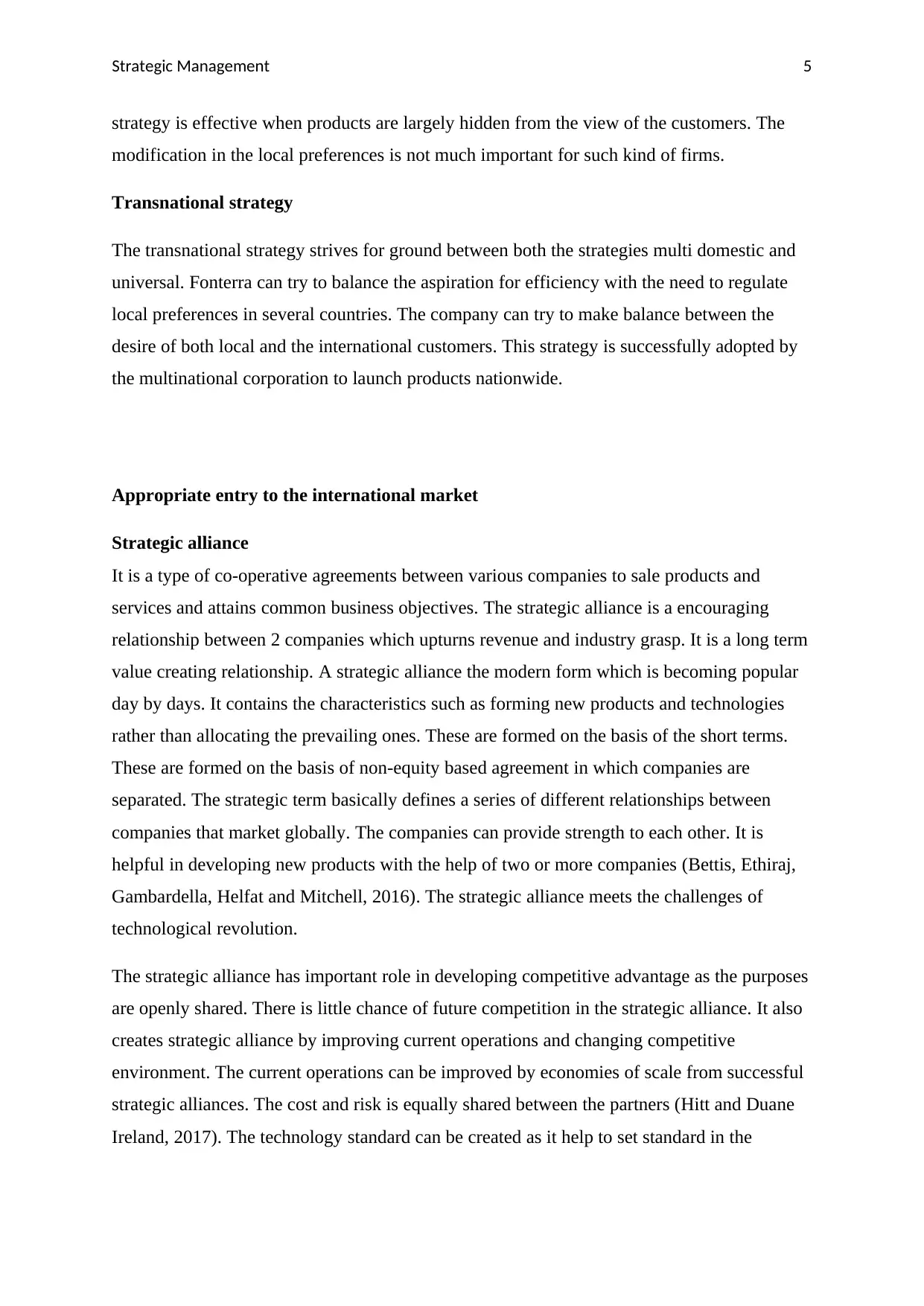
Strategic Management 5
strategy is effective when products are largely hidden from the view of the customers. The
modification in the local preferences is not much important for such kind of firms.
Transnational strategy
The transnational strategy strives for ground between both the strategies multi domestic and
universal. Fonterra can try to balance the aspiration for efficiency with the need to regulate
local preferences in several countries. The company can try to make balance between the
desire of both local and the international customers. This strategy is successfully adopted by
the multinational corporation to launch products nationwide.
Appropriate entry to the international market
Strategic alliance
It is a type of co-operative agreements between various companies to sale products and
services and attains common business objectives. The strategic alliance is a encouraging
relationship between 2 companies which upturns revenue and industry grasp. It is a long term
value creating relationship. A strategic alliance the modern form which is becoming popular
day by days. It contains the characteristics such as forming new products and technologies
rather than allocating the prevailing ones. These are formed on the basis of the short terms.
These are formed on the basis of non-equity based agreement in which companies are
separated. The strategic term basically defines a series of different relationships between
companies that market globally. The companies can provide strength to each other. It is
helpful in developing new products with the help of two or more companies (Bettis, Ethiraj,
Gambardella, Helfat and Mitchell, 2016). The strategic alliance meets the challenges of
technological revolution.
The strategic alliance has important role in developing competitive advantage as the purposes
are openly shared. There is little chance of future competition in the strategic alliance. It also
creates strategic alliance by improving current operations and changing competitive
environment. The current operations can be improved by economies of scale from successful
strategic alliances. The cost and risk is equally shared between the partners (Hitt and Duane
Ireland, 2017). The technology standard can be created as it help to set standard in the
strategy is effective when products are largely hidden from the view of the customers. The
modification in the local preferences is not much important for such kind of firms.
Transnational strategy
The transnational strategy strives for ground between both the strategies multi domestic and
universal. Fonterra can try to balance the aspiration for efficiency with the need to regulate
local preferences in several countries. The company can try to make balance between the
desire of both local and the international customers. This strategy is successfully adopted by
the multinational corporation to launch products nationwide.
Appropriate entry to the international market
Strategic alliance
It is a type of co-operative agreements between various companies to sale products and
services and attains common business objectives. The strategic alliance is a encouraging
relationship between 2 companies which upturns revenue and industry grasp. It is a long term
value creating relationship. A strategic alliance the modern form which is becoming popular
day by days. It contains the characteristics such as forming new products and technologies
rather than allocating the prevailing ones. These are formed on the basis of the short terms.
These are formed on the basis of non-equity based agreement in which companies are
separated. The strategic term basically defines a series of different relationships between
companies that market globally. The companies can provide strength to each other. It is
helpful in developing new products with the help of two or more companies (Bettis, Ethiraj,
Gambardella, Helfat and Mitchell, 2016). The strategic alliance meets the challenges of
technological revolution.
The strategic alliance has important role in developing competitive advantage as the purposes
are openly shared. There is little chance of future competition in the strategic alliance. It also
creates strategic alliance by improving current operations and changing competitive
environment. The current operations can be improved by economies of scale from successful
strategic alliances. The cost and risk is equally shared between the partners (Hitt and Duane
Ireland, 2017). The technology standard can be created as it help to set standard in the
⊘ This is a preview!⊘
Do you want full access?
Subscribe today to unlock all pages.

Trusted by 1+ million students worldwide
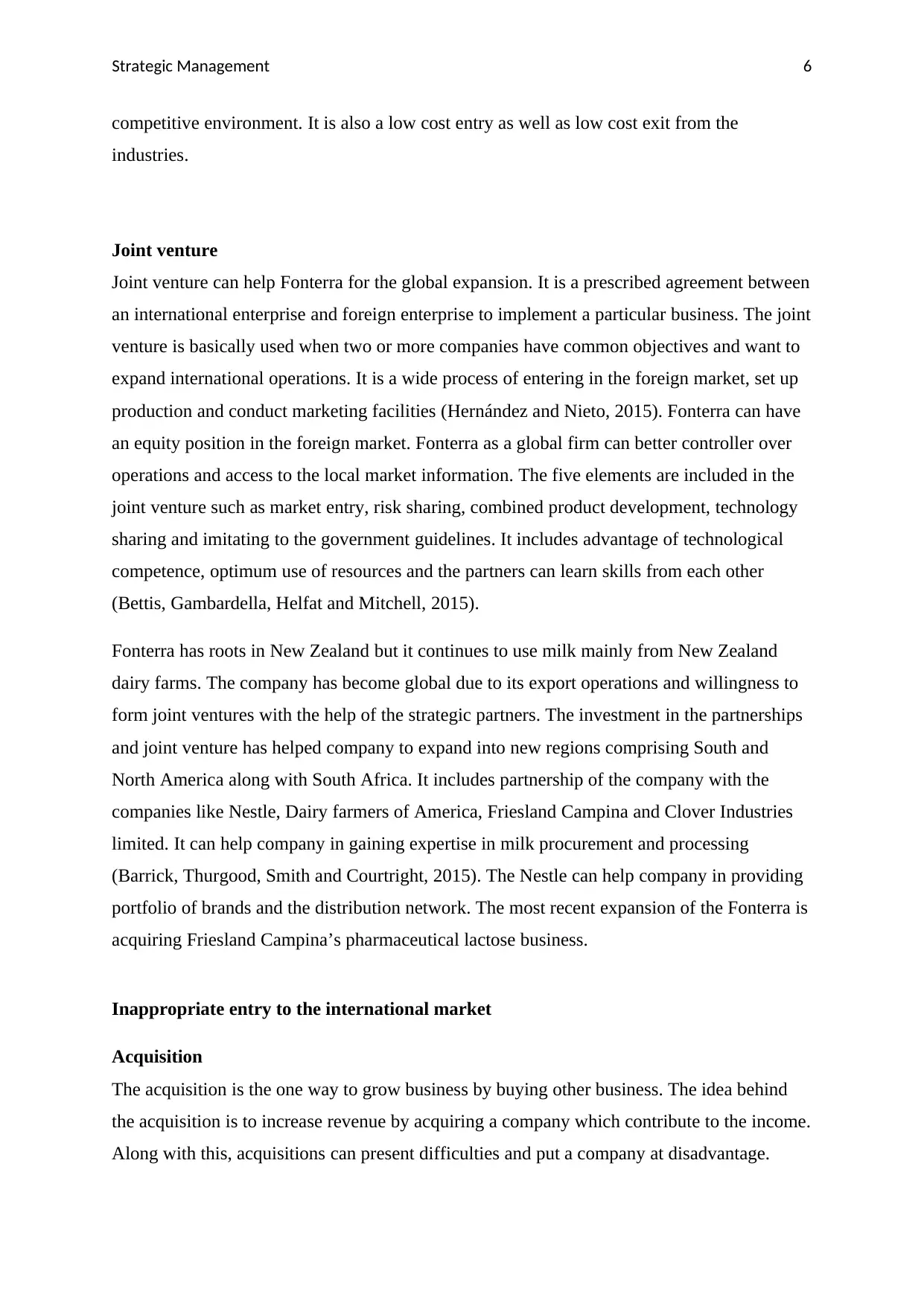
Strategic Management 6
competitive environment. It is also a low cost entry as well as low cost exit from the
industries.
Joint venture
Joint venture can help Fonterra for the global expansion. It is a prescribed agreement between
an international enterprise and foreign enterprise to implement a particular business. The joint
venture is basically used when two or more companies have common objectives and want to
expand international operations. It is a wide process of entering in the foreign market, set up
production and conduct marketing facilities (Hernández and Nieto, 2015). Fonterra can have
an equity position in the foreign market. Fonterra as a global firm can better controller over
operations and access to the local market information. The five elements are included in the
joint venture such as market entry, risk sharing, combined product development, technology
sharing and imitating to the government guidelines. It includes advantage of technological
competence, optimum use of resources and the partners can learn skills from each other
(Bettis, Gambardella, Helfat and Mitchell, 2015).
Fonterra has roots in New Zealand but it continues to use milk mainly from New Zealand
dairy farms. The company has become global due to its export operations and willingness to
form joint ventures with the help of the strategic partners. The investment in the partnerships
and joint venture has helped company to expand into new regions comprising South and
North America along with South Africa. It includes partnership of the company with the
companies like Nestle, Dairy farmers of America, Friesland Campina and Clover Industries
limited. It can help company in gaining expertise in milk procurement and processing
(Barrick, Thurgood, Smith and Courtright, 2015). The Nestle can help company in providing
portfolio of brands and the distribution network. The most recent expansion of the Fonterra is
acquiring Friesland Campina’s pharmaceutical lactose business.
Inappropriate entry to the international market
Acquisition
The acquisition is the one way to grow business by buying other business. The idea behind
the acquisition is to increase revenue by acquiring a company which contribute to the income.
Along with this, acquisitions can present difficulties and put a company at disadvantage.
competitive environment. It is also a low cost entry as well as low cost exit from the
industries.
Joint venture
Joint venture can help Fonterra for the global expansion. It is a prescribed agreement between
an international enterprise and foreign enterprise to implement a particular business. The joint
venture is basically used when two or more companies have common objectives and want to
expand international operations. It is a wide process of entering in the foreign market, set up
production and conduct marketing facilities (Hernández and Nieto, 2015). Fonterra can have
an equity position in the foreign market. Fonterra as a global firm can better controller over
operations and access to the local market information. The five elements are included in the
joint venture such as market entry, risk sharing, combined product development, technology
sharing and imitating to the government guidelines. It includes advantage of technological
competence, optimum use of resources and the partners can learn skills from each other
(Bettis, Gambardella, Helfat and Mitchell, 2015).
Fonterra has roots in New Zealand but it continues to use milk mainly from New Zealand
dairy farms. The company has become global due to its export operations and willingness to
form joint ventures with the help of the strategic partners. The investment in the partnerships
and joint venture has helped company to expand into new regions comprising South and
North America along with South Africa. It includes partnership of the company with the
companies like Nestle, Dairy farmers of America, Friesland Campina and Clover Industries
limited. It can help company in gaining expertise in milk procurement and processing
(Barrick, Thurgood, Smith and Courtright, 2015). The Nestle can help company in providing
portfolio of brands and the distribution network. The most recent expansion of the Fonterra is
acquiring Friesland Campina’s pharmaceutical lactose business.
Inappropriate entry to the international market
Acquisition
The acquisition is the one way to grow business by buying other business. The idea behind
the acquisition is to increase revenue by acquiring a company which contribute to the income.
Along with this, acquisitions can present difficulties and put a company at disadvantage.
Paraphrase This Document
Need a fresh take? Get an instant paraphrase of this document with our AI Paraphraser
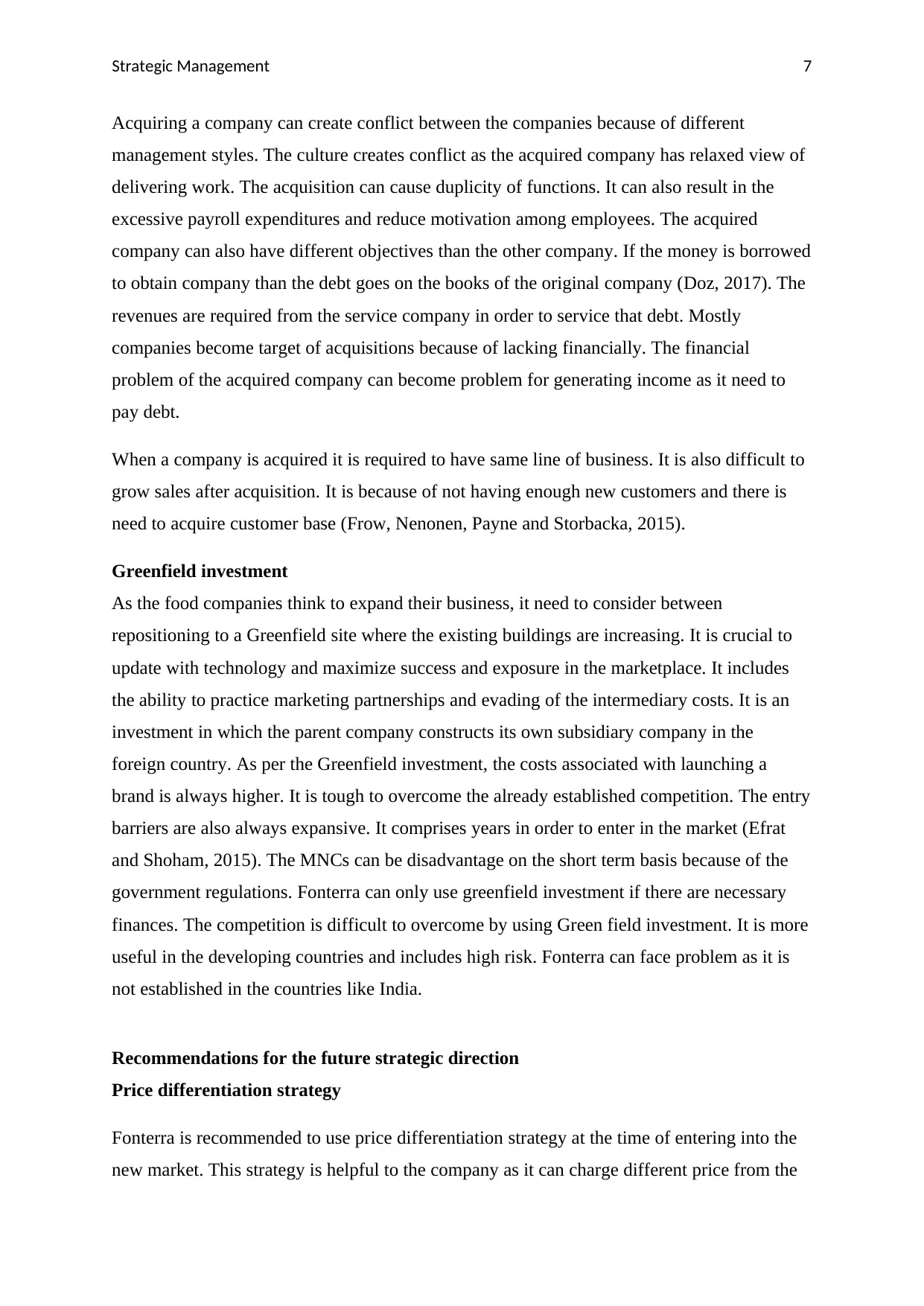
Strategic Management 7
Acquiring a company can create conflict between the companies because of different
management styles. The culture creates conflict as the acquired company has relaxed view of
delivering work. The acquisition can cause duplicity of functions. It can also result in the
excessive payroll expenditures and reduce motivation among employees. The acquired
company can also have different objectives than the other company. If the money is borrowed
to obtain company than the debt goes on the books of the original company (Doz, 2017). The
revenues are required from the service company in order to service that debt. Mostly
companies become target of acquisitions because of lacking financially. The financial
problem of the acquired company can become problem for generating income as it need to
pay debt.
When a company is acquired it is required to have same line of business. It is also difficult to
grow sales after acquisition. It is because of not having enough new customers and there is
need to acquire customer base (Frow, Nenonen, Payne and Storbacka, 2015).
Greenfield investment
As the food companies think to expand their business, it need to consider between
repositioning to a Greenfield site where the existing buildings are increasing. It is crucial to
update with technology and maximize success and exposure in the marketplace. It includes
the ability to practice marketing partnerships and evading of the intermediary costs. It is an
investment in which the parent company constructs its own subsidiary company in the
foreign country. As per the Greenfield investment, the costs associated with launching a
brand is always higher. It is tough to overcome the already established competition. The entry
barriers are also always expansive. It comprises years in order to enter in the market (Efrat
and Shoham, 2015). The MNCs can be disadvantage on the short term basis because of the
government regulations. Fonterra can only use greenfield investment if there are necessary
finances. The competition is difficult to overcome by using Green field investment. It is more
useful in the developing countries and includes high risk. Fonterra can face problem as it is
not established in the countries like India.
Recommendations for the future strategic direction
Price differentiation strategy
Fonterra is recommended to use price differentiation strategy at the time of entering into the
new market. This strategy is helpful to the company as it can charge different price from the
Acquiring a company can create conflict between the companies because of different
management styles. The culture creates conflict as the acquired company has relaxed view of
delivering work. The acquisition can cause duplicity of functions. It can also result in the
excessive payroll expenditures and reduce motivation among employees. The acquired
company can also have different objectives than the other company. If the money is borrowed
to obtain company than the debt goes on the books of the original company (Doz, 2017). The
revenues are required from the service company in order to service that debt. Mostly
companies become target of acquisitions because of lacking financially. The financial
problem of the acquired company can become problem for generating income as it need to
pay debt.
When a company is acquired it is required to have same line of business. It is also difficult to
grow sales after acquisition. It is because of not having enough new customers and there is
need to acquire customer base (Frow, Nenonen, Payne and Storbacka, 2015).
Greenfield investment
As the food companies think to expand their business, it need to consider between
repositioning to a Greenfield site where the existing buildings are increasing. It is crucial to
update with technology and maximize success and exposure in the marketplace. It includes
the ability to practice marketing partnerships and evading of the intermediary costs. It is an
investment in which the parent company constructs its own subsidiary company in the
foreign country. As per the Greenfield investment, the costs associated with launching a
brand is always higher. It is tough to overcome the already established competition. The entry
barriers are also always expansive. It comprises years in order to enter in the market (Efrat
and Shoham, 2015). The MNCs can be disadvantage on the short term basis because of the
government regulations. Fonterra can only use greenfield investment if there are necessary
finances. The competition is difficult to overcome by using Green field investment. It is more
useful in the developing countries and includes high risk. Fonterra can face problem as it is
not established in the countries like India.
Recommendations for the future strategic direction
Price differentiation strategy
Fonterra is recommended to use price differentiation strategy at the time of entering into the
new market. This strategy is helpful to the company as it can charge different price from the
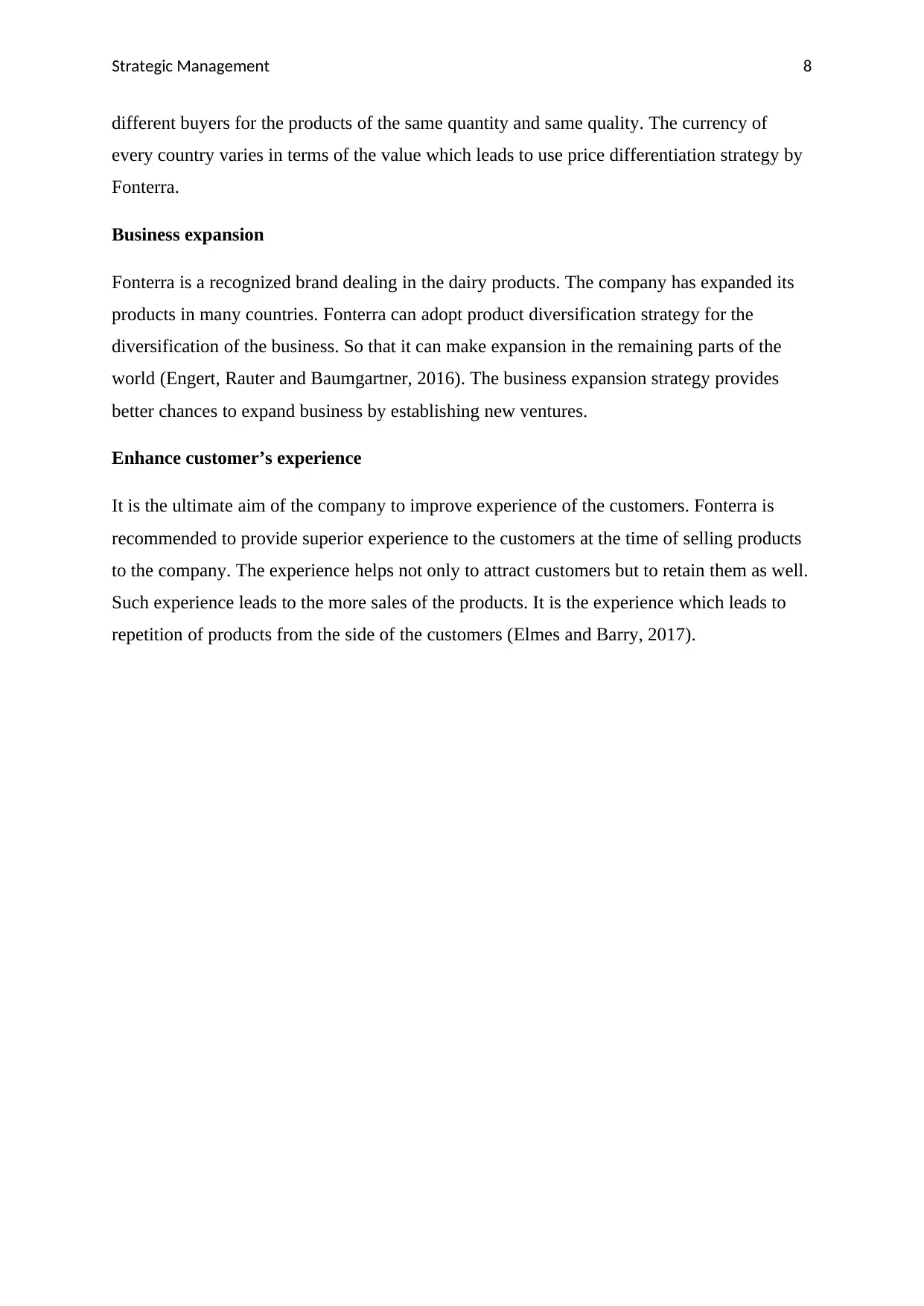
Strategic Management 8
different buyers for the products of the same quantity and same quality. The currency of
every country varies in terms of the value which leads to use price differentiation strategy by
Fonterra.
Business expansion
Fonterra is a recognized brand dealing in the dairy products. The company has expanded its
products in many countries. Fonterra can adopt product diversification strategy for the
diversification of the business. So that it can make expansion in the remaining parts of the
world (Engert, Rauter and Baumgartner, 2016). The business expansion strategy provides
better chances to expand business by establishing new ventures.
Enhance customer’s experience
It is the ultimate aim of the company to improve experience of the customers. Fonterra is
recommended to provide superior experience to the customers at the time of selling products
to the company. The experience helps not only to attract customers but to retain them as well.
Such experience leads to the more sales of the products. It is the experience which leads to
repetition of products from the side of the customers (Elmes and Barry, 2017).
different buyers for the products of the same quantity and same quality. The currency of
every country varies in terms of the value which leads to use price differentiation strategy by
Fonterra.
Business expansion
Fonterra is a recognized brand dealing in the dairy products. The company has expanded its
products in many countries. Fonterra can adopt product diversification strategy for the
diversification of the business. So that it can make expansion in the remaining parts of the
world (Engert, Rauter and Baumgartner, 2016). The business expansion strategy provides
better chances to expand business by establishing new ventures.
Enhance customer’s experience
It is the ultimate aim of the company to improve experience of the customers. Fonterra is
recommended to provide superior experience to the customers at the time of selling products
to the company. The experience helps not only to attract customers but to retain them as well.
Such experience leads to the more sales of the products. It is the experience which leads to
repetition of products from the side of the customers (Elmes and Barry, 2017).
⊘ This is a preview!⊘
Do you want full access?
Subscribe today to unlock all pages.

Trusted by 1+ million students worldwide
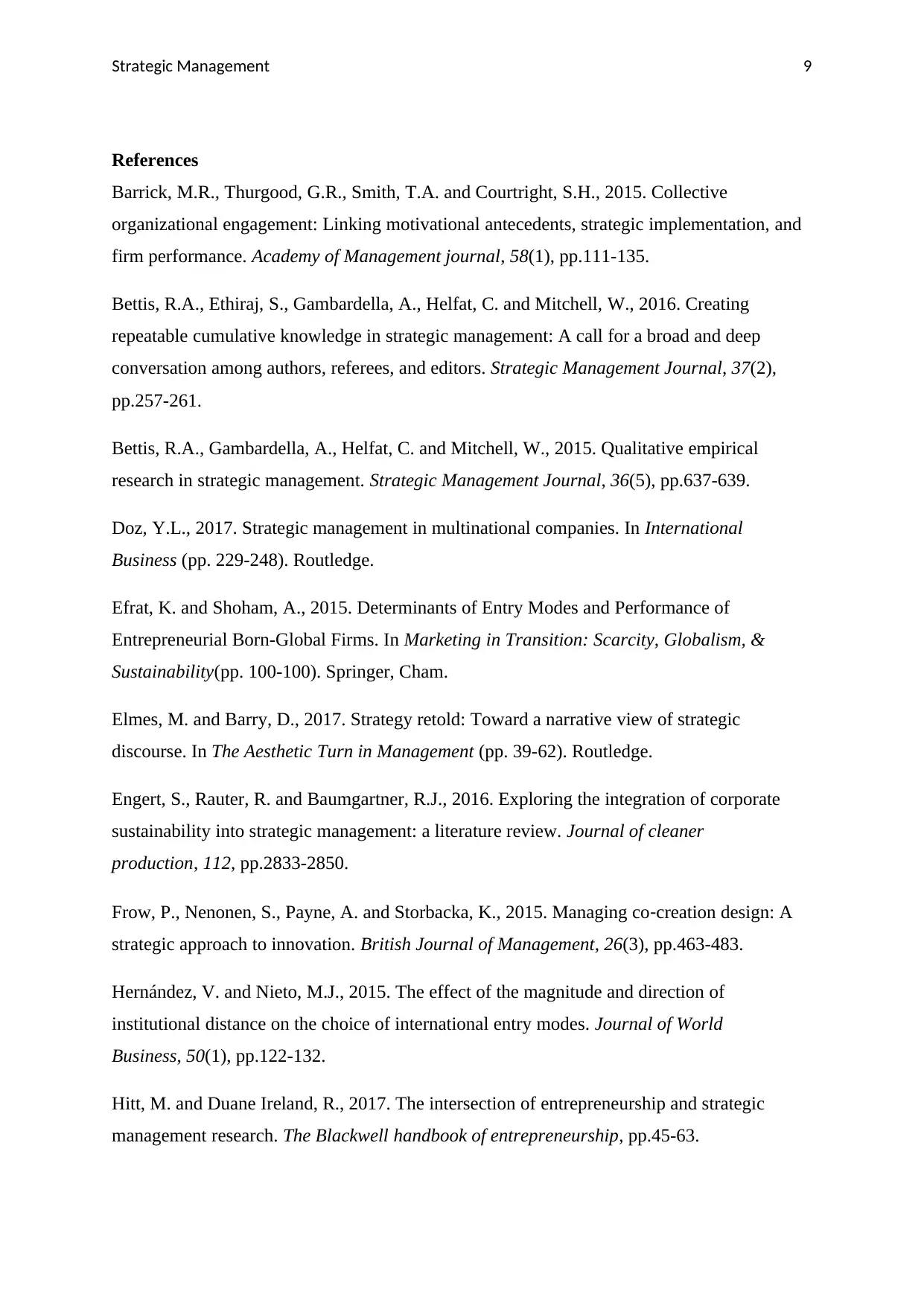
Strategic Management 9
References
Barrick, M.R., Thurgood, G.R., Smith, T.A. and Courtright, S.H., 2015. Collective
organizational engagement: Linking motivational antecedents, strategic implementation, and
firm performance. Academy of Management journal, 58(1), pp.111-135.
Bettis, R.A., Ethiraj, S., Gambardella, A., Helfat, C. and Mitchell, W., 2016. Creating
repeatable cumulative knowledge in strategic management: A call for a broad and deep
conversation among authors, referees, and editors. Strategic Management Journal, 37(2),
pp.257-261.
Bettis, R.A., Gambardella, A., Helfat, C. and Mitchell, W., 2015. Qualitative empirical
research in strategic management. Strategic Management Journal, 36(5), pp.637-639.
Doz, Y.L., 2017. Strategic management in multinational companies. In International
Business (pp. 229-248). Routledge.
Efrat, K. and Shoham, A., 2015. Determinants of Entry Modes and Performance of
Entrepreneurial Born-Global Firms. In Marketing in Transition: Scarcity, Globalism, &
Sustainability(pp. 100-100). Springer, Cham.
Elmes, M. and Barry, D., 2017. Strategy retold: Toward a narrative view of strategic
discourse. In The Aesthetic Turn in Management (pp. 39-62). Routledge.
Engert, S., Rauter, R. and Baumgartner, R.J., 2016. Exploring the integration of corporate
sustainability into strategic management: a literature review. Journal of cleaner
production, 112, pp.2833-2850.
Frow, P., Nenonen, S., Payne, A. and Storbacka, K., 2015. Managing co‐creation design: A
strategic approach to innovation. British Journal of Management, 26(3), pp.463-483.
Hernández, V. and Nieto, M.J., 2015. The effect of the magnitude and direction of
institutional distance on the choice of international entry modes. Journal of World
Business, 50(1), pp.122-132.
Hitt, M. and Duane Ireland, R., 2017. The intersection of entrepreneurship and strategic
management research. The Blackwell handbook of entrepreneurship, pp.45-63.
References
Barrick, M.R., Thurgood, G.R., Smith, T.A. and Courtright, S.H., 2015. Collective
organizational engagement: Linking motivational antecedents, strategic implementation, and
firm performance. Academy of Management journal, 58(1), pp.111-135.
Bettis, R.A., Ethiraj, S., Gambardella, A., Helfat, C. and Mitchell, W., 2016. Creating
repeatable cumulative knowledge in strategic management: A call for a broad and deep
conversation among authors, referees, and editors. Strategic Management Journal, 37(2),
pp.257-261.
Bettis, R.A., Gambardella, A., Helfat, C. and Mitchell, W., 2015. Qualitative empirical
research in strategic management. Strategic Management Journal, 36(5), pp.637-639.
Doz, Y.L., 2017. Strategic management in multinational companies. In International
Business (pp. 229-248). Routledge.
Efrat, K. and Shoham, A., 2015. Determinants of Entry Modes and Performance of
Entrepreneurial Born-Global Firms. In Marketing in Transition: Scarcity, Globalism, &
Sustainability(pp. 100-100). Springer, Cham.
Elmes, M. and Barry, D., 2017. Strategy retold: Toward a narrative view of strategic
discourse. In The Aesthetic Turn in Management (pp. 39-62). Routledge.
Engert, S., Rauter, R. and Baumgartner, R.J., 2016. Exploring the integration of corporate
sustainability into strategic management: a literature review. Journal of cleaner
production, 112, pp.2833-2850.
Frow, P., Nenonen, S., Payne, A. and Storbacka, K., 2015. Managing co‐creation design: A
strategic approach to innovation. British Journal of Management, 26(3), pp.463-483.
Hernández, V. and Nieto, M.J., 2015. The effect of the magnitude and direction of
institutional distance on the choice of international entry modes. Journal of World
Business, 50(1), pp.122-132.
Hitt, M. and Duane Ireland, R., 2017. The intersection of entrepreneurship and strategic
management research. The Blackwell handbook of entrepreneurship, pp.45-63.
Paraphrase This Document
Need a fresh take? Get an instant paraphrase of this document with our AI Paraphraser
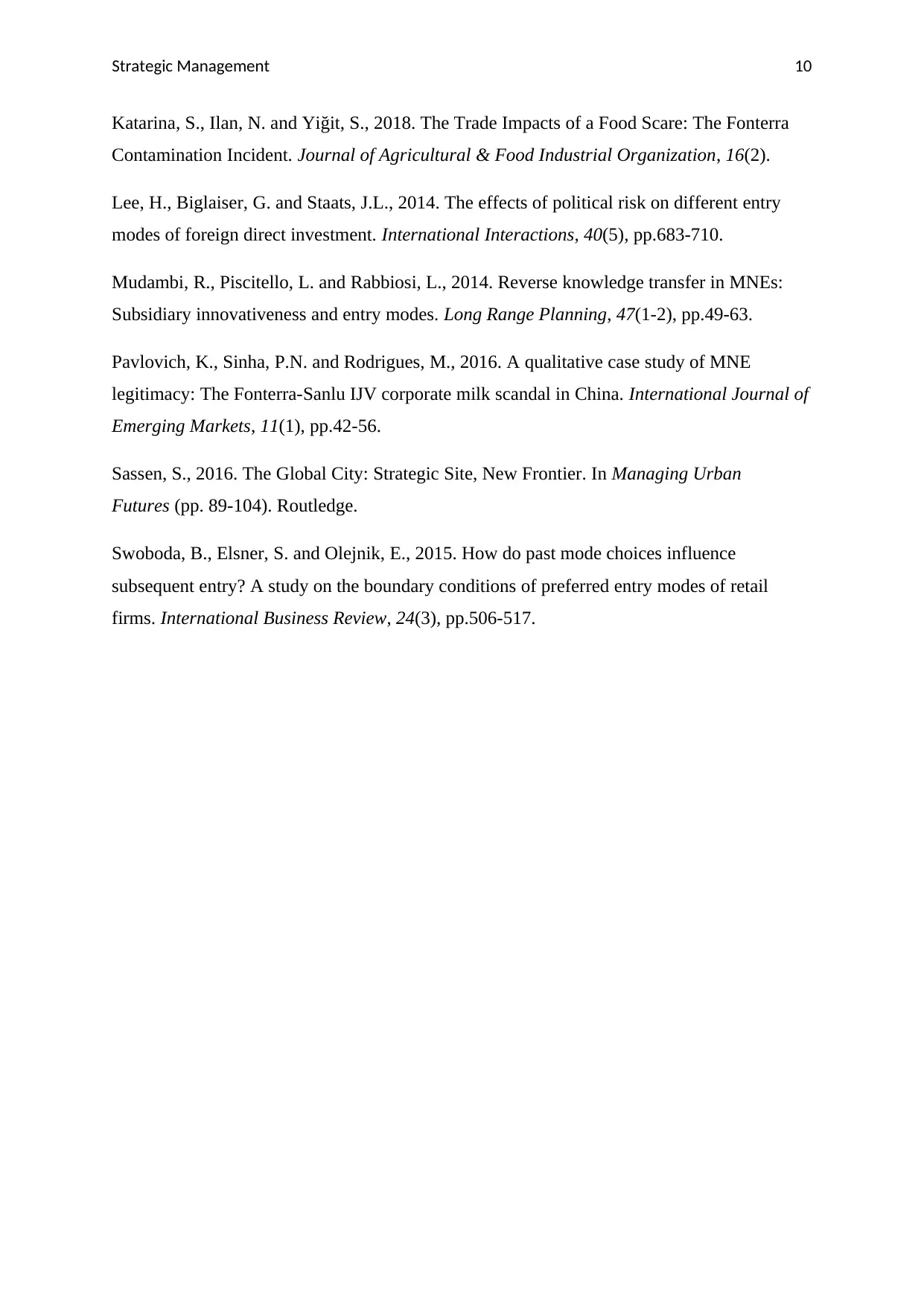
Strategic Management 10
Katarina, S., Ilan, N. and Yiğit, S., 2018. The Trade Impacts of a Food Scare: The Fonterra
Contamination Incident. Journal of Agricultural & Food Industrial Organization, 16(2).
Lee, H., Biglaiser, G. and Staats, J.L., 2014. The effects of political risk on different entry
modes of foreign direct investment. International Interactions, 40(5), pp.683-710.
Mudambi, R., Piscitello, L. and Rabbiosi, L., 2014. Reverse knowledge transfer in MNEs:
Subsidiary innovativeness and entry modes. Long Range Planning, 47(1-2), pp.49-63.
Pavlovich, K., Sinha, P.N. and Rodrigues, M., 2016. A qualitative case study of MNE
legitimacy: The Fonterra-Sanlu IJV corporate milk scandal in China. International Journal of
Emerging Markets, 11(1), pp.42-56.
Sassen, S., 2016. The Global City: Strategic Site, New Frontier. In Managing Urban
Futures (pp. 89-104). Routledge.
Swoboda, B., Elsner, S. and Olejnik, E., 2015. How do past mode choices influence
subsequent entry? A study on the boundary conditions of preferred entry modes of retail
firms. International Business Review, 24(3), pp.506-517.
Katarina, S., Ilan, N. and Yiğit, S., 2018. The Trade Impacts of a Food Scare: The Fonterra
Contamination Incident. Journal of Agricultural & Food Industrial Organization, 16(2).
Lee, H., Biglaiser, G. and Staats, J.L., 2014. The effects of political risk on different entry
modes of foreign direct investment. International Interactions, 40(5), pp.683-710.
Mudambi, R., Piscitello, L. and Rabbiosi, L., 2014. Reverse knowledge transfer in MNEs:
Subsidiary innovativeness and entry modes. Long Range Planning, 47(1-2), pp.49-63.
Pavlovich, K., Sinha, P.N. and Rodrigues, M., 2016. A qualitative case study of MNE
legitimacy: The Fonterra-Sanlu IJV corporate milk scandal in China. International Journal of
Emerging Markets, 11(1), pp.42-56.
Sassen, S., 2016. The Global City: Strategic Site, New Frontier. In Managing Urban
Futures (pp. 89-104). Routledge.
Swoboda, B., Elsner, S. and Olejnik, E., 2015. How do past mode choices influence
subsequent entry? A study on the boundary conditions of preferred entry modes of retail
firms. International Business Review, 24(3), pp.506-517.
1 out of 11
Related Documents
Your All-in-One AI-Powered Toolkit for Academic Success.
+13062052269
info@desklib.com
Available 24*7 on WhatsApp / Email
![[object Object]](/_next/static/media/star-bottom.7253800d.svg)
Unlock your academic potential
Copyright © 2020–2025 A2Z Services. All Rights Reserved. Developed and managed by ZUCOL.





